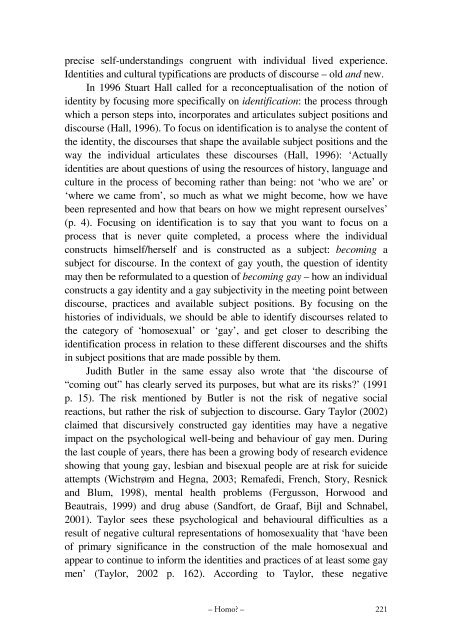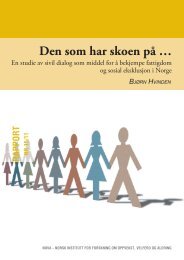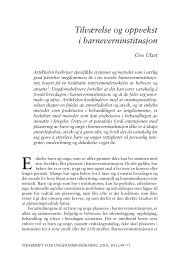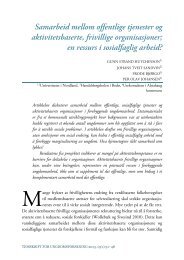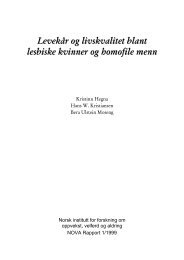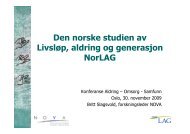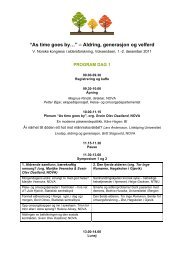Betydningen av seksuell erfaring, tiltrekning og identitet for ...
Betydningen av seksuell erfaring, tiltrekning og identitet for ...
Betydningen av seksuell erfaring, tiltrekning og identitet for ...
Create successful ePaper yourself
Turn your PDF publications into a flip-book with our unique Google optimized e-Paper software.
precise self-understandings congruent with individual lived experience.<br />
Identities and cultural typifications are products of discourse – old and new.<br />
In 1996 Stuart Hall called <strong>for</strong> a reconceptualisation of the notion of<br />
identity by focusing more specifically on identification: the process through<br />
which a person steps into, incorporates and articulates subject positions and<br />
discourse (Hall, 1996). To focus on identification is to analyse the content of<br />
the identity, the discourses that shape the <strong>av</strong>ailable subject positions and the<br />
way the individual articulates these discourses (Hall, 1996): ‘Actually<br />
identities are about questions of using the resources of history, language and<br />
culture in the process of becoming rather than being: not ‘who we are’ or<br />
‘where we came from’, so much as what we might become, how we h<strong>av</strong>e<br />
been represented and how that bears on how we might represent ourselves’<br />
(p. 4). Focusing on identification is to say that you want to focus on a<br />
process that is never quite completed, a process where the individual<br />
constructs himself/herself and is constructed as a subject: becoming a<br />
subject <strong>for</strong> discourse. In the context of gay youth, the question of identity<br />
may then be re<strong>for</strong>mulated to a question of becoming gay – how an individual<br />
constructs a gay identity and a gay subjectivity in the meeting point between<br />
discourse, practices and <strong>av</strong>ailable subject positions. By focusing on the<br />
histories of individuals, we should be able to identify discourses related to<br />
the category of ‘homosexual’ or ‘gay’, and get closer to describing the<br />
identification process in relation to these different discourses and the shifts<br />
in subject positions that are made possible by them.<br />
Judith Butler in the same essay also wrote that ‘the discourse of<br />
“coming out” has clearly served its purposes, but what are its risks?’ (1991<br />
p. 15). The risk mentioned by Butler is not the risk of negative social<br />
reactions, but rather the risk of subjection to discourse. Gary Taylor (2002)<br />
claimed that discursively constructed gay identities may h<strong>av</strong>e a negative<br />
impact on the psychol<strong>og</strong>ical well-being and beh<strong>av</strong>iour of gay men. During<br />
the last couple of years, there has been a growing body of research evidence<br />
showing that young gay, lesbian and bisexual people are at risk <strong>for</strong> suicide<br />
attempts (Wichstrøm and Hegna, 2003; Remafedi, French, Story, Resnick<br />
and Blum, 1998), mental health problems (Fergusson, Horwood and<br />
Beautrais, 1999) and drug abuse (Sand<strong>for</strong>t, de Graaf, Bijl and Schnabel,<br />
2001). Taylor sees these psychol<strong>og</strong>ical and beh<strong>av</strong>ioural difficulties as a<br />
result of negative cultural representations of homosexuality that ‘h<strong>av</strong>e been<br />
of primary significance in the construction of the male homosexual and<br />
appear to continue to in<strong>for</strong>m the identities and practices of at least some gay<br />
men’ (Taylor, 2002 p. 162). According to Taylor, these negative<br />
– Homo? – 221


